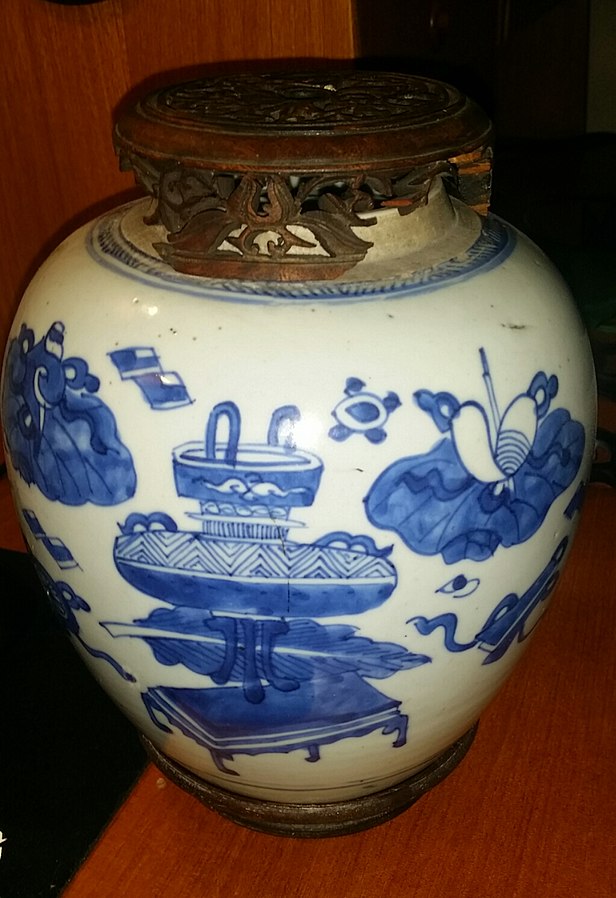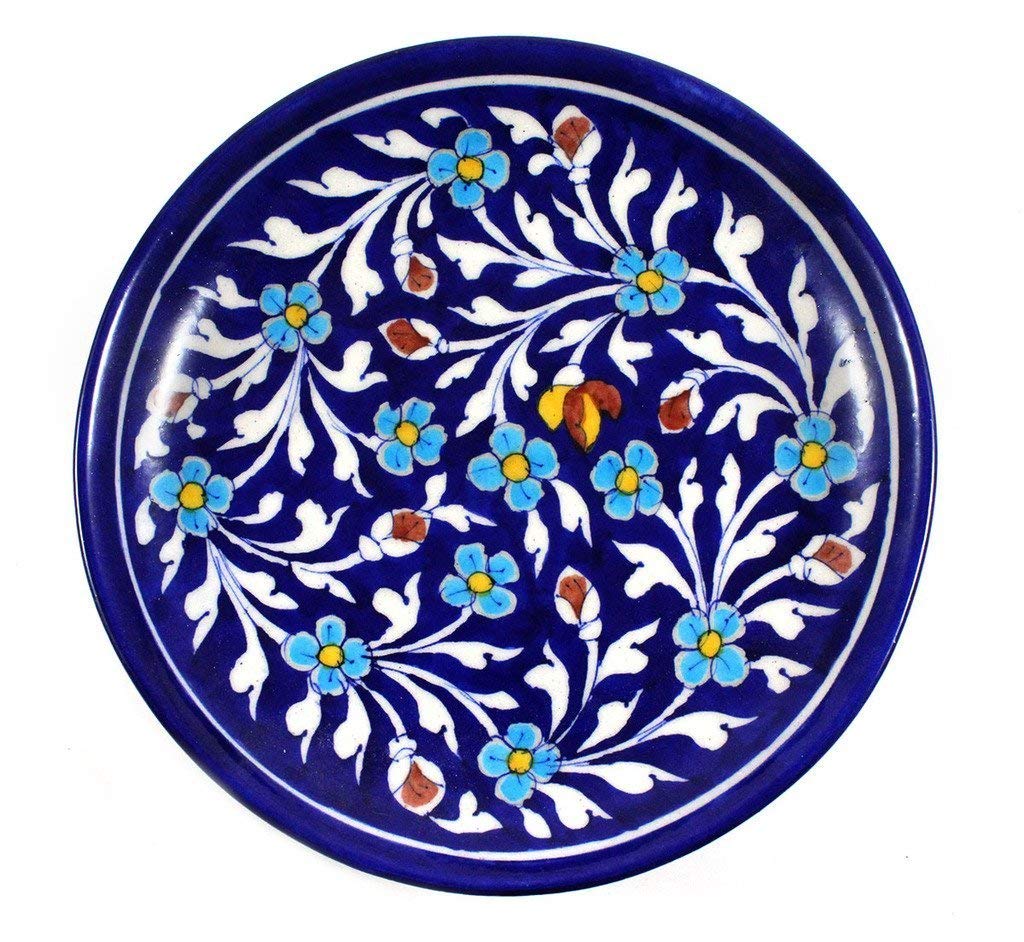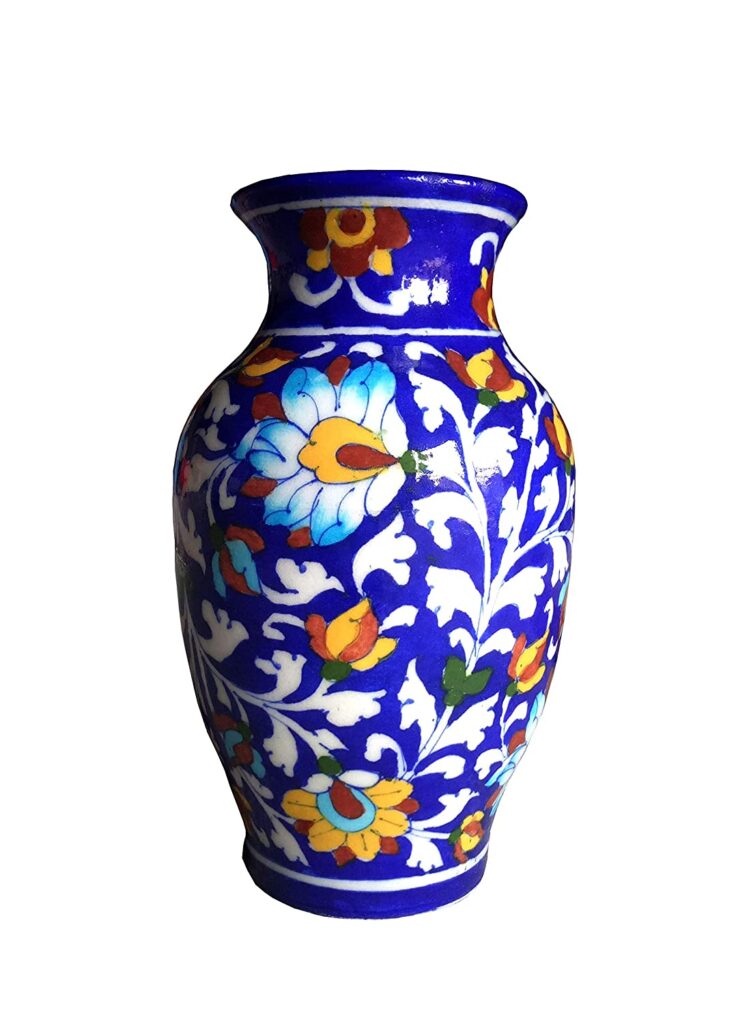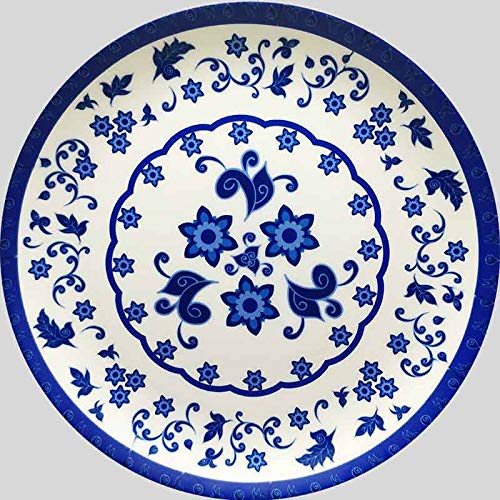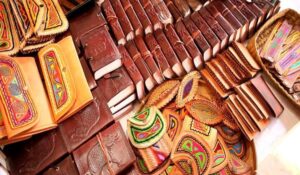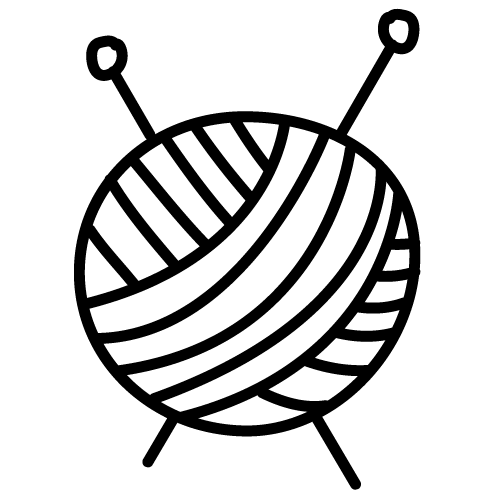Everything you need to know about
Blue Pottery.
When you hear about the Indian city of Jaipur, the first thing that comes into our mind is that it is the pink city of India.
This beautiful city is home to the Hawa mahal and many historic places of significance.
Apart from this, it also is the place of origin of an extremely stunning traditional craft of India, blue pottery.
The blue pottery craft of Jaipur actually is of Turko-Persian origin.
It is the most luxurious form of Indian pottery made with a cobalt blue dye.
This kind of craft is inspired by Eurasian, Islamic and Chinese pottery.
It is mostly used as decor due to its fragile properties.
Aari embroidery includes the utilization of many beads and needles.
Salma, Gota, Nakshi, Dabka, as well as Aara, are few of the variations associated with this craftwork.
Aari embroidery is generally linked with flowery themes.
Even Katori, Sitara and Tikena are a few components that are employed in this artwork.
All these aids in producing mesmerising and creative patterns.
The influence of geographical location and the extremely diverse history of India can still be felt to this day.
The traditional arts and crafts of the local regions that are still being celebrated and practised is one such example of this influence.
Blue pottery is the symbol of luxury in handicrafts.
It is made of expensive dyes and fragile materials, making it extremely popular among collectables from India.
Jaipur is rich in the semi-precious stone of quartz, hence it is the hub of blue pottery in India.
This ancient craft has survived through generations and is still extremely popular not only in India but all over the world.
So let’s try to learn more about this tradition of India in details.
How did Blue Pottery reach India?
The use of glazed blue dye in pottery is a foreign technique.
It was first created by Mongolian Artisans.
They corroborated the glazing technique of Chinese pottery with the Persian way of decorating and crafts.
This technique reached the eastern part of India in the 14th century with several Turkish and Islamic invasions.
Before coming into its existence in India, this form of art was used extensively in Central Asia and the middle-east.
Various floor tiles, walls and figurines of mosques and tombs were made from utilising the earlier techniques of blue pottery.
With the Islamic invasion in India, Mughals began using this art form in the Indian Subcontinent.
Chinese porcelain was continuously imported into Indian courts and incorporated
However, this art form was still limited to architecture until it slowly seeped into the traditional art of pottery in India.
It travelled to Delhi and then finally to Jaipur in the 17th century.
Jaipur was founded by Swami Jai Singh I in 1727.
The city was made with corroborating different art and styles of India and Blue pottery was one of them.
Slowly, as more and more people were trained in blue pottery, it became increasingly popular in Jaipur.
There is actually a very interesting story related to the recognition of blue pottery in Jaipur.
Ram Singh II once attended a kite flying session where he saw that two men from Achnera had defeated every other kite in the sky.
Later, he learned that they were actually potters.
They had coated their string with the same blue glass that they used in their pottery.
Ram Singh II was so impressed by the work that he invited both of them to stay in Jaipur and teach this form of glazed pottery in the art school.
What are the raw materials used in Blue Pottery?
As mentioned above, Blue pottery uses unique and distinct raw materials.
The distinct blue colour of this art form is derived from cobalt oxide.
Blue forms the base and structure of the motifs of this pottery.
Other colours like green and yellow are also used sometimes to enhance the designs.
Green is derived from copper oxide, turquoise from copper sulphate, brown is produced from iron oxide while calcium oxide provides with the yellow colour.
Blue pottery is the only form of pottery that is made without the use of conventional clay.
In place of clay, a mixture of quartz powder, powdered glass, fuller’s earth (Multani Mitti), borax and gum is used.
They all are heated at the same temperature and moulded in the shape of the final product after a tedious process.
So what exactly is this process that only extremely skilled craftsmen are able to carry it out?
Let’s find out.
What is the process of making Blue Pottery?
The whole process of making Blue Pottery is extremely intricate and tedious.
At first, the raw materials of the base including glass, quartz, fuller’s earth, etc are grounded in a traditional chakki.
Afterwards, they are measured and fixed in the right proportions.
This mixture is then blended with water and made into a dough.
The base dough is kept sealed in plastic bags to retain moisture.
This dough is then flattened with a traditional wooden tool.
The flattened dough is spread into tools and the edges are trimmed with knives and scissors.
The artisans add ash to these moulds so that no deformation of shape takes place.
Once the dough sets in, the mould is lifted or broken and the ash in it is removed.
The final shape is polished with sandpaper and coated with a mixture of quartz, flour and glass.
The next step involves the colouring and designing of the pottery, Bruises made from squirrel hair are dipped in various dyes and unique shapes and motifs are painted on the pottery.
The next step is the traditional technique of glazing of China.
It requires powdered glass, borax and lead oxides.
These materials are kept inside the kiln, the kiln drips these materials into cold water from its bottom.
This glaze in a molten form is collected in the form of lumps and is grounded into a fine powder.
This fine powder is applied to the designed product before it is heated.
The pottery is then put into this kiln and heated up to 800 degrees with the help of wood and coal.
After, giving it 2-3 days to cool, the final product is removed from the kiln.
All the final products of this process are semi-transparent with absolutely stunning motifs and designs.
What are some difficulties faced by potters?
The whole long process of making blue pottery is extremely tiring and time-consuming.
Artisans and potters have to be extremely specific and attentive to details to produce good quality products.
Apart from a long process, potters making this blue pottery face extreme competition in both national and international markets.
With the development of machinery, potters are struggling to make a livelihood from handicrafts.
The tedious process of Blue pottery doesn’t help.
However, they are still continuing their fight for recognition. People adore blue pottery.
It is used to make tiles for floors and walls, lamps, utensils and luxurious crockery used in modern homes.
How is Blue Pottery surviving in these modern times?
Various initiatives are being taken to protect this handicraft and history of India.
A GI (Geographical Index) mark has been developed so that artisans can retain their designs and the identity of their craft.
Leela Bordia has started n organization called Neerja International in order to retain this art and help the generational artisans of Jaipur.
They have spent 3 decades developing the skills of people and providing them with security and self-reliance abilities in the artists of Jaipur.
Artisans have started making daily objects to help with their sales.
Products like vases, small bowls, plates, ashtrays, lamps, soap dishes, pen stands, photo-frames, hangers, jewellery, etc are being made to increase the market of Blue pottery.
Earlier only Persian motifs and designs were used in this art form.
Slowly, Indian artists have developed their own designs ranging from geometric shapes to floral patterns.
Figures from Indian Mythology are also painted on some products.
Ne of the unique feature of Blue pottery is that no two designs are the same.
Artists use such different techniques and designs that it is almost impossible for any two products to be similar.
It contributes to the rare quality of Blue Pottery, making it extremely unique and luxurious.
Blue pottery could have been extinct by now if it was not for all the efforts of various individuals and the artists.
They have fought it to keep it alive and popular all around the world.
Today, it is a major employment form of the artists in Jaipur.
It is providing livelihood to generations of families.
This form of handicrafts is an indispensable part of Indian History.
It is the symbol of diversity and how the Persian and Chinese culture still continues to influence our art.
It provides us with an opportunity to know more about how India was formed and established after continuous foreign invasions.
We absorbed everything good from these cultural and political influences to give space to what is the most diverse country in the world.
Blue Pottery is the reminder os the beauty we hold within our land.
We should encourage ourselves to support these artisans and potters who work hard to keep this art alive.
Knowing more about them is the first step we did here in order to support this handicraft.
Please let us know about anything you think I missed in the comments down below.
We will try to incorporate it in future.
Till then, stay tuned to know more about the diverse handicrafts of India.
Did we miss something?
Let us know in the comments down below!



